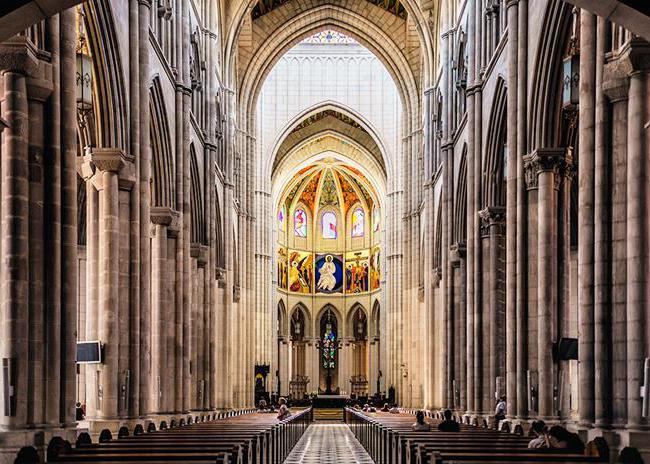Having visited the Spanish capital, it is impossible to ignore the stunning beauty of Almuden Cathedral. The splendor of the interior, the unique combination of architectural styles, the bewitching beauty of the Cathedral of Santa Maria la Real de la Almudena attracts both tourists and local residents. It will be discussed in the article.
Legends and traditions
The mysterious history of the Almuden Cathedral in Madrid is known and enjoyed by every Spaniard. Legend has it that the apostle James, preaching Christianity and converting the pagans, brought to the territory of modern Spain a figurine of the Virgin Mary. Soon, the Arabs seized power in the country. Local residents hid the sacred relic and for many years they could not find it. In 1083, the country was liberated from Muslims. After a solemn prayer, King Alphonse VI drove through the city streets with a festive procession. The wall of the fortress collapsed and an intact statue of the Virgin appeared to the eyes of all those gathered. Translated from Arabic, Al mudayna means a citadel or fortress. And the returned relic began to be called the Virgin of Almudena.
Today in the temple there is a statue of the 16th century, which the inhabitants of Madrid venerate as the protector of the city of Virgo Almudena.
Cathedral Construction
Not being the center of the diocese, the city did not have a cathedral. Having proclaimed Madrid the capital of the state in the 16th century, King Philip II set out to build a church on the site of an Arab mosque. But construction was constantly delayed due to political and economic instability in the country. In 1883, after the sudden death of his wife, King of Spain Alphonse XII built a crypt in which the statue of Mary of Almudena was established.

In 1884, Pope Leo XIII established the diocese of Madrid. The capital acquired a bishop and the church received the status of a cathedral. The project was originally created in a neo-Gothic style by the Marquis of Francisco de Cubas. The construction of the great church has repeatedly stopped and dragged on for more than 100 years. In 1944, the project was finalized and corrected by architects Fernando Chueca-Goitia and Carl Sidro. The personal consecration of the completed cathedral by Pope John Paul II took place only in June 1993. The statue of the Pope in the square in front of the temple testifies to this significant event.
Architectural ensemble
Located on the Arms Square opposite the Royal Palace, Almudena Cathedral, combining neo-romanticism with a neo-Gothic and Baroque style in its exterior, forms an organic ensemble with the residence of the monarchs. In the construction of the temple used limestone, sandstone, marble and granite. The light gray facades of the cathedral and the palace in the style of Erreresco harmoniously complement each other. The huge bronze entrance gate to the temple is decorated with a story about the mysterious discovery of the statue of the Virgin Mary. The high (75 m) dome of the cathedral was built under the direction of Chueca Goitia in the neo-baroque style.
The interior of the Cathedral of Almudena
A distinctive feature of the temple is its location. Traditionally, the churches "look" to the west and east, and the Almuden Cathedral in Madrid faces south and north. Its internal layout resembles a Latin cross. The very bright space of the temple is modestly decorated with numerous figures, canvases, murals and mosaics. In the chapels of the cathedral are important burials of the XIX century. The main altar of Granada green marble is crowned with the crucifixion of Christ in the Baroque style, made in the XVII century by Juan de Mesa.
In the space behind the altar there is a painting by Francisco Rizzi, “Removing the Garments from Christ,” painted at the same time. The left wing of the transept is decorated with a plaster painting, “Immaculate with Fleur de Lis,” dating from the 16th century. The chairs of the choirs made at the end of the 16th century from walnut were transferred from the old church of St. Carmen to the cathedral.
The most majestic and significant decorations of the chapels of the cathedral are the figure of the Virgin and the amazing beauty of the retablo Juan of Burgundy, made in the 16th century, the statue of John the Baptist, the work of Michel of the 18th century, “Christ Tied to a Pillar” by Giacomo Colombo. A casket with the remains of St. Isidra is kept in the altar passage. The restrained beauty of the spacious temple and the huge mosaic dome shock visitors with its grandeur.
Visit to the cathedral
Celebrations in honor of the Virgin of Almuden are held in the cathedral annually on November 9. The great church and the royal family are not ignoring it: the Spanish prince, and today the king of Spain, Philip VI , married in May 2004 in the Almuden Cathedral with his bride, TV presenter Letizia Ortiz. The cathedral accepts visitors free of charge daily throughout the year, with the exception of some public holidays. A cursory inspection of the entire temple takes about an hour.
The lucky ones who attend the service will forever remember the magnificent organ music and the singing of the church choir. There is a museum at the temple, where for 6 euros you can see church jewelry, clothes, books and interior details. Under the dome of the arch there is an observation deck with a stunning view of the city streets.
Having settled in a hotel near the Almudena Cathedral (7 islas, Hotel City House Florida Norte Madrid), you will have the opportunity to thoroughly explore the sights of central Madrid: visit the San Miguel bazaar, the Royal Opera House, the richest monastery in Europe - the Monastery of Barefoot Princesses Descalzas Reales and many other amazingly beautiful places.